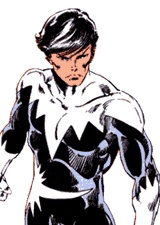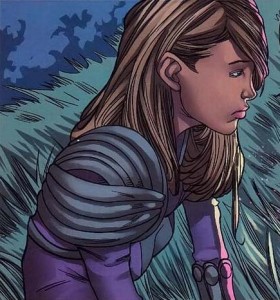Daken, Wolverine’s son, yields the power of controlling his body’s pheromones. He uses this ability in order to seduce, lure in, and manipulate members of both sexes in his favor. He is on the border of good and evil, he is witty, intelligent, quick-thinking, and incredibly fit. He has to this day never officially came out as being bisexual, gay, or even straight, although he appears to be quite comfortable with luring in both men and women when using his superpowers.
When Northstar was first created, Marvel had a strict “No Gays in Marvel Comics” ban, created by the editor-in-chief during the early 1970s. However, the comic’s illustrator and writer had always intended for Northstar to be openly gay. He received much of his characterization in the early 1980s, when Marvel shifted corporate power and the comic company was open to new ideas. North, who is capable of moving at the speeds of light and blinding flashes when working in unison with his twin sister, has maintained subtle references to his sexuality for more than three decades of comics. Comics can thank Northstar for breaking many of the original boundaries of representing gays and the lgbt community in comicbooks. If it weren’t for him, as well as creators Chris Claremont and artist John Byrne, superheros may not be as expansive and representative of diversity as they are today.
Hulkling and Wiccan are two superhero fan boys that just happen to have special powers. Originally, Hulkling was supposed to be a woman who transformed into a Hulk body. However, the creators of the comic decided they would try something different by having two of the newest Avengers be gays who were not defined by their sexuality — this was just to be one specific trait the two possessed. Their relationship with each other is personal and realistic. They are not what most media outlets generally characterize gay relationships or people by. They are bold, daring, and in love. It is an admirable relationship to respect, and they contribute to the newest league of superheros, which has been designed to challenge some of the standard norms in the comic book industry.
Anole was originally set to have a very short lifespan in the comic book world. The creators at Marvel would have done quite the injustice to his character if they had gone with their original plan, which was to merely have him come out to his closest superhero friends regarding his sexuality and immediately be rejected. From his inception into the Young Mutants, Marvel had planned to have him commit suicide. Instead, he began to receive popularity in fan bases for his unique reptile features and fast-paced superpowers. He has since remained alive, been put in the spotlight a number of times, and challenged the norms of lgbt representation. One of his most famous moments was when he helped another young gay superhero come to terms with his sexuality, notably helping him cope with it and ultimately doing exactly the opposite of what the creators originally had designed him for — suicide.
Xavin may perhaps be the most complex superhero in any comic. Readers are unsure is she was even born a man or woman. She is capable of breaking gender roles by morphing from man to woman seamlessly. Originally, she was dating another superhero as a man and fell in love. When she morphed almost permanently into a woman, they continued their love for each other and had a healthy relationship as women. Her nonconformity into any specific gender provides trans representation, and is an important lesson for comic book creators and readers that there is truly no need to place a label or representation on any of their superheros, except for good and evil. She truly represents and depicts everything Judith Butler had noted in her essay on gender insubordination. She refuses to be defined by her one specific trait; instead, she uses it as an entity in order to further expand her capabilities and unlimited potential as a superhero.
Karma is one of the most wildly popular lesbian superheros in Marvel comics. A refugee from Vietnam, the caretaker of her family, a doer of justice and good across the globe, and a fighter for global peace, Karma deserves her name for fighting for justice and putting evil in its place. She gained popularity for her original appearances in comics in the 1980’s, and Marvel is planning on bringing her back into the limelight in a series of new works and possibly even films. She has always been an outwardly lesbian superhero, and her sexuality is just one of the many dozen attributes that fans list when describing her on social media and popular superhero websites as “one badass chick”.
Apollo and The Midnighter are essentially to Indie comics what Superman and Batman are to DC comics — One epic cape wearing seeker of justice, the other a street vigilante equipped with fast cars, ammo, and a passion for taking down evil. The two fell in love in the first series of their comic, and their wedding was even shown within their first several issues. While they are quite notably referenced often for being gay, and their representation of the LGBT community is strong and apparent, it serves as a friendly reminder to the rest of the comic book industry that gays in comics are just as capable of having plot-thickening story lines which readers will enjoy, and take delight in reading. These two characters may come from different walks of life, but together they are absolutely unstoppable: isn’t that what superhero love is all about?
Batwoman may be the most notable LGBT representation in comics due to her close ties with Batman. This isn’t the original straight-laced 1950s batwoman, either. This is the tattooed, gun-toting, black and red leather military brat who doesn’t take sh*t from anyone, and is often vocal about her opinions when it comes to the league. As DC’s highest profile LGBT rep, she was redesigned in 2006 in order to expand the company’s diversification, however, she does so much more than that. Batwoman serves as a bigger picture to anyone who reads comics, gay or straight: She reminds us that, no matter who we are, and what traits we have that others may define as flaws, we’re all pretty badass in our own right. We should be exactly who we are, and constantly fight to make sure we never give up on the things we believe in.
All of these representations of the LGBT community do so much more than simply diversify our comics. They provide an insight to the true capabilities our media has in breaking down the walls and norms which confine our television, movies, books, etc. These comics provide some of the first visuals into how an outlet for entertainment can also be a threshold for new norms and standards in society. They teach us that superheros, like all other people, come in various walks of life. Their sexuality is merely one trait in a long list of qualities superheros possess, and shouldn’t simply be judged by who they choose to love — or, in some cases, who they choose to lure in with mind-bending pheromones in order to get what they want.
Sources:
Abelove, Henry, Michèle Aina Barale, and David M. Halperin. “Imitation and Gender Insubordination.” The Lesbian and gay studies reader. New York: Routledge, 1993. 307-320. Print.
“Keeping Up With the Gays of DC and Marvel.” Out Magazine. N.p., n.d. Web. 13 Aug. 2014. <http://www.out.com/entertainment/popnography/2012/10/11/keeping-gays-dc-and-marvel?page=full>.
“Top Ten LGBT Comic Superheroes | TQS Magazine.” TQS Magazine. N.p., n.d. Web. 13 Aug. 2014. <http://www.tqsmagazine.co.uk/top-ten-lgbt-comic-superheroes/>.







